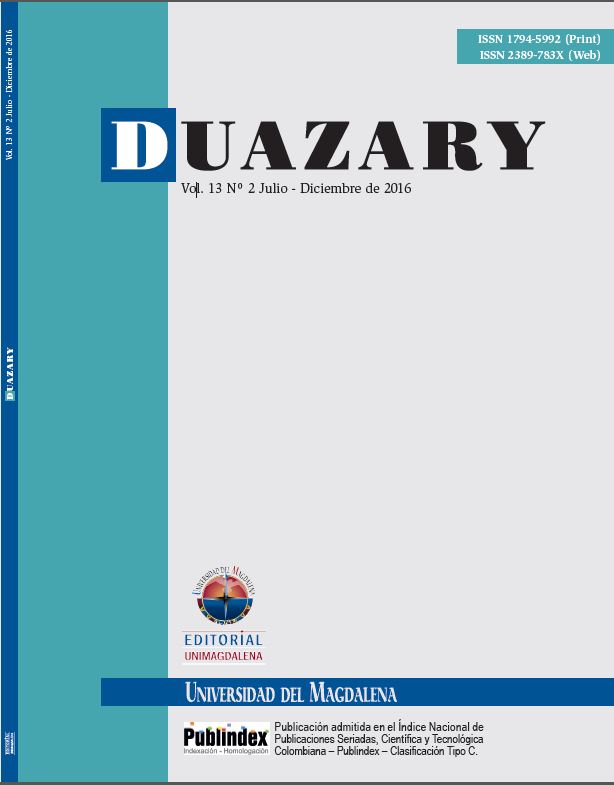Age and leukocyte count as prognostic factors on acute lymphoblastic leukemia: hgmlal07 cohort
Main Article Content
Abstract
In order to establish the cutoff with prognostic implications for white blood cell count and age at diagnosis in adults with acute lymphoblastic leukemia (ALL), we conducted an observational, descriptive and analytical study nested in a retrospective cohort of patients with ALL treated by institutional protocol HGMLAL07 during 2007-2014. We study 255 patients, the 52.9% (n=135) were female and 47.1% (n=120) were male. The mean age was 31 (16-80) years-old. The disease-free survival (DFS) decreases in both genders after 20 years-old (p = 0.001). Leukocyte count average was 56.1 x 109/L (0.1-850 x 109/L). DFS decreases significantly from an equal or greater leukocyte count of 20 x 109/L (p<0.05). With this results, we can conclude that use foreign cutoff for age and leukocyte count could determine a bad prognosis stratification and a consequent suboptimal treatment.
Downloads
Article Details
References
Swerdlow SH, Campo E, Harris NL, Jaffe ES, Pileri SA, Stein H, et al., editors. WHO Classification of Tumours of Haematopoietic and Lymphoid Tissues. 4th ed. World Health Organization Classification of Tumours of Haematopoietic and Lymphoid Tissue. Lyon: International Agency for Research on Cancer Press; 2008.
Nath S V, Nicholson I, Tapp H, Zola H, Zannettino ACW, Revesz T. Reticulin fibres anchor leukaemic blasts in the marrow of patients with acute lymphoblastic leukaemia. Med Hypotheses. 2011;77(3):333–5.
Gökbuget N, Hoelzer D. Treatment of adult acute lymphoblastic leukemia. Semin Hematol. 2009;46(1):64–75.
Talpaz M, Shah NP, Kantarjian H, Donato N, Nicoll J, Paquette R, et al. Dasatinib in imatinib-resistant Philadelphia chromosome-positive leukemias. N Engl J Med. 2006;354(24):2531–41.
Sanford DS, Kantarjian H, O’Brien S, Jabbour E, Cortes J, Ravandi F. The role of ponatinib in Philadelphia chromosome-positive acute lymphoblastic leukemia. Expert Rev Anticancer Ther. 2015;15(4):365–73.
Portell CA, Advani AS. Antibody therapy for acute lymphoblastic leukemia. Curr Hematol Malig Rep. 2012;7(2):153–9.
Ai J, Advani A. Current status of antibody therapy in ALL. Br J Haematol. 2015;168(4):471–80.
Pui C-H, Carroll WL, Meshinchi S, Arceci RJ. Biology, risk stratification, and therapy of pediatric acute leukemias: an update. J Clin Oncol. 2011;29(5):551–65.
Chiaretti S, Vitale A, Cazzaniga G, Orlando SM, Silvestri D, Fazi P, et al. Clinico-biological features of 5202 patients with acute lymphoblastic leukemia enrolled in the Italian AIEOP and GIMEMA protocols and stratified in age cohorts. Haematologica. 2013;98(11):1702–10.
Hoelzer D, Thiel E, Löffler H, Ganser A, Heimpel H, Büchner T, et al. Risk groups in adult acute lymphoblastic leukemia. Haematol Blood Transfus. 1987;30:104–10.
Rowe JM, Buck G, Burnett AK, Chopra R, Wiernik PH, Richards SM, et al. Induction therapy for adults with acute lymphoblastic leukemia: results of more than 1500 patients from the international ALL trial: MRC UKALL XII/ECOG E2993. Blood. 2005;106(12):3760–7.
Wang H, Chen X-Q, Geng Q-R, Liu P-P, Lin G-N, Xia Z-J, et al. Induction therapy using the MRC UKALLXII/ECOG E2993 protocol in Chinese adults with acute lymphoblastic leukemia. Int J Hematol. 2011;94(2):163–8.
Larson RA, Dodge RK, Burns CP, Lee EJ, Stone RM, Schulman P, et al. A five-drug remission induction regimen with intensive consolidation for adults with acute lymphoblastic leukemia: cancer and leukemia group B study 8811. Blood. American Society of Hematology; 1995;85(8):2025–37.
Annino L, Vegna ML, Camera A, Specchia G, Visani G, Fioritoni G, et al. Treatment of adult acute lymphoblastic leukemia (ALL): long-term follow-up of the GIMEMA ALL 0288 randomized study. Blood. 2002;99(3):863–71.
Ramos C, Rozen E, León M, Martínez T A, Olarte I, Catellanos H, et al. [Results of treatment of acute lymphoblastic leukemia in two cohorts of Mexican patients]. Rev Med Chil. 2011;139(9):1135–42.
Jaso J, Thomas DA, Cunningham K, Jorgensen JL, Kantarjian HM, Medeiros LJ, et al. Prognostic significance of immunophenotypic and karyotypic features of Philadelphia positive B-lymphoblastic leukemia in the era of tyrosine kinase inhibitors. Cancer. 2011;117(17):4009–17.
Jiménez-Morales S, Miranda-Peralta E, Saldaña-Alvarez Y, Perez-Vera P, Paredes-Aguilera R, Rivera-Luna R, et al. BCR-ABL, ETV6-RUNX1 and E2A-PBX1: prevalence of the most common acute lymphoblastic leukemia fusion genes in Mexican patients. Leuk Res. 2008;32(10):1518–22.
Ganzel C, Rowe JM. Prognostic factors in adult acute leukemia. Hematol Oncol Clin North Am. 2011;25(6):1163–87.
Dores GM, Devesa SS, Curtis RE, Linet MS, Morton LM. Acute leukemia incidence and patient survival among children and adults in the United States, 2001-2007. Blood. 2012;119(1):34–43.
Sant M, Allemani C, Tereanu C, Angelis R De, Capocaccia R, Marcos-gragera R, et al. Incidence of hematologic malignancies in Europe by morphologic subtype: results of the HAEMACARE project. Blood. 2010;116(19):3724–34.
De França Azevedo I, da Silva Júnior RMP, de Vasconcelos AVM, das Neves WB, de Barros Correia Melo FC, Melo RAM. Frequency of p190 and p210 BCR-ABL rearrangements and survival in Brazilian adult patients with acute lymphoblastic leukemia. Rev Bras Hematol Hemoter. 36(5):351–5.
Hoelzer D, Thiel E, Löffler H, Büchner T, Ganser A, Heil G, et al. Prognostic factors in a multicenter study for treatment of acute lymphoblastic leukemia in adults. Blood. 1988;71(1):123–31.
Gokbuget N, Kneba M, Raff T, Trautmann H, Bartram C-R, Arnold R, et al. Adult patients with acute lymphoblastic leukemia and molecular failure display a poor prognosis and are candidates for stem cell transplantation and targeted therapies. Blood. American Society of Hematology. 2012;120(9):1868–76.
Van Zant G, Liang Y. Concise Review: Hematopoietic Stem Cell Aging, Life Span, and Transplantation. Stem Cells Transl Med. 2012;1(9):651–7.

